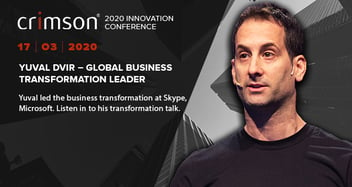How can CIOs enable digitisation within traditional organisations?
 The theme at Crimson’s Innovation Conference 2016 is ‘enabling digitisation’, we will be discussing CIOs’ digital implementation strategies and the issues that obstruct these plans.
The theme at Crimson’s Innovation Conference 2016 is ‘enabling digitisation’, we will be discussing CIOs’ digital implementation strategies and the issues that obstruct these plans.
One of the biggest barriers to the introduction of digital technology is an archaic hierarchical structure of leadership within a company.
This article examines the difficulties experienced by chief information officers (CIOs) that work within traditional organisations, or those with rigid power structures.
When digitisation meets a legacy culture
Often CIOs join organisations that have a famous name, an excellent history, and a good reputation. Many of these companies will have already embraced digital innovation to ‘some extent’ and many have senior stakeholders that have seen the benefits in what other companies have achieved through state-of-the-art technologies.
However…
With these types of companies, many CIOs struggle to get buy-in from key decision makers. Why? Because of fear of repercussions, a dislike of change, or company politics.
In a lot of organisations there is an endemic cultural resistance to technological changes. Leaders don’t fully recognise that this resistance is embedded throughout the company, growing over decades of shared frustrations and restrictions.
If you are a CIO and you’re looking at moving to a new company, you can find indicators of this resistance held between different departments, in the networks of contacts, and in the incentives structure, which is usually geared toward the leaders of the company.
Often decision makers are sincere in their intention to compete in the digital world. They are willing to invest in and build the necessary skills, but they frequently fail to grasp the cultural resistance and don’t know how to overcome it.
Some CIOs act as if all they have to do is present a fact-based analysis of the top and bottom-line benefits of delivering a complete digital strategy, for the necessary changes to be implemented and inevitable success to ensue. Not a chance.
Senior managers fail to make the necessary decisions to shift resources and reallocate responsibilities and some will be reluctant to sign-off certain decisions in case there are repercussions if a plan does not work out.
So, how do CIOs change a company’s culture & teach stakeholders to embrace digitisation?
Digital technology may be difficult to introduce, but don’t let your company’s culture hold you back from competing against your rivals in the market place.
As a CIO are there are a number of variables that you can effect to bring about digital change in your organisation and transform its culture.
Formal variables effect the structures of management, including; incentives / bonuses, reporting lines, and career paths. CIOs need to take ownership over these variables to achieve the desired results:
- Leadership policies: For your digital strategy to succeed you need 100% ‘buy-in’ from the top of the company. This backing should be documented, voiced, and shown in the actions of stakeholders.
- Defined roles: Job descriptions detail what staff do. Key performance indicators (KPIs) need to be set that reflect the organisation’s strategic digital objectives.
- People processes: Ensure that your human resources department understands the critical need to hire, train, and reward people in line with your goal of delivering your digital strategy.
- Key behaviours: CIOs must work with departmental heads to identify and implement a few incremental changes in everyday practices that will support the digitisation process.
- Role models: Identify (or hire) people who epitomise the key behaviours and see the benefits in digitisation. Promote them throughout the company.
- Networks: Encourage all employees to take part in informal networks, such as clubs and social groups, to spread the word about the changes and benefits that are being caused by digitisation.
If you would like to join the digital discussion, register to the Crimson Innovation Conference for FREE by clicking the image below.
Crimson are an IT consultancy, an IT solutions provider, an IT recruitment agency, and a Microsoft Gold Partner with offices in Birmingham and the City of London.


